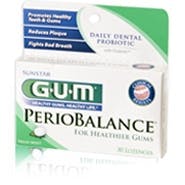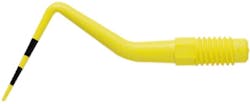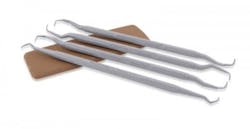Proper maintenance, patient education can determine success or failure of periodontal therapy
By Maria Perno Goldie, RDH, MS
In order to know the role of the dental hygienist in the treatment of periodontal disease, we must first understand the epidemiology and prevalence, the pathology, and the etiology of the disease. Risk assessment is critical for accurate treatment, and working collaboratively with dentists and periodontists means discussing and understanding referral guidelines. Outcome measures for nonsurgical therapy should be set and assessed, and referral for surgical intervention should be discussed when nonsurgical therapy does not control the disease. Proper maintenance and patient education can mean the difference between success and failure.As skilled health professionals, dental hygienists have the education to assess, treat, and maintain the health of oral tissues, most often in conjunction with a dentist. This is dictated by state rules, regulations, and laws, which are implemented and governed by state dental hygiene and dental boards. We know the periodontal diseases can affect various parts of the body, so maintaining optimal oral health can also help in the maintenance of good general health. In recent years, there has been much research in the link between oral general health interest in the role of oral infections and inflammation on oral tissues and other sites in the body. Some of the areas of study are diabetes, adverse pregnancy outcomes, cardiovascular and cerebrovascular diseases, respiratory diseases, and even some cancers. Assessment, primary health care screenings, and patient education may have an enormous impact on public health, as 60% of adults in the United States are reported as visiting a dental office at least once a year.(1) Regarding assessment, clinical oral examinations are vital, as well as reviewing and documenting medical history. Detection of hypertension, sleep apnea, visible dermatologic lesions, osteoporosis, diabetes, obesity, and lifestyle factors like tobacco use is vital to overall health management. In some cases, patients will share this information with you. in other cases, we may find something that requires a medical consultation. Identification of patients with undiagnosed diseases, such as diabetes, can lead to improved management of patients and perhaps a reduction in morbidity, mortality, and a savings in health care expenditures, having the potential for a significant public health impact.(2) In 2011 the American Academy of Periodontology (AAP) released a Position Paper that set forth the scope, objective, and procedures that constitute periodontal therapy.(3) Removal of supra- and subgingival bacterial plaque biofilm and calculus by comprehensive, meticulous, periodontal scaling and root planning is a major part of treatment procedures, as well as patient education, training in oral hygiene, and counseling on control of risk factors with appropriate referral if needed.Implant evaluation is a key element in a periodontal maintenance appointment. The goals of implant maintenance procedures are: maintenance of optimal oral health and prevention of peri-implant disease. The assessment should include: the quality of the peri-implant tissue; presence of plaque and calculus; radiographic appearance of implant; presence of suppuration in the peri-implant tissue; presence of salivary percolation; mobility of the implant or prosthesis; and patient comfort and function. Be aware that peri-implant infections can progress more rapidly than in a natural dentition, and that the first line of defense is the perimucosal seal. Knowing how to identify a changing implant environment is vital in a re-care appointment. There are early failures and late failures. Early Failure (within 1st year) can be due to patients conditions, such as: poor bone quality and quantity; medical conditions that affect bone healing; unfavorable habits such as bruxism, heavy long term smoking; and poor oral hygiene and plaque accumulation.(4) Poor surgical insertion technique can lead to lack of osseointergration. Osseointergration takes place in phases: the healing phase of 0-12 months, the remodeling phase of 3-18 months, and the steady state that occurs after 18 months. Late failure, after one year, can be caused by: occlusal trauma; excessive loading; poor occlusal design; bruxism not previously diagnosed; poor prosthesis design; poor lab technique; defective implant components, loose screws, and fractures. Another reason for implant failure is peri-Implantitis, which may be attributed to inadequate dental hygiene, lack of dexterity, poor aesthetic design making hygiene difficult, or inadequate professional supervision of oral hygiene and self care.The cause of periodontal diseases is an infection. It is not like a typical infection, but acts more like an opportunistic infection.(5) As a biofilm-mediated disease, periodontal disease is difficult to treat, as there is no way to totally eliminate pathogenic bacteria from the oral cavity. As there are also good bacteria, the goal is to maintain a healthy balance.
In order to know the role of the dental hygienist in the treatment of periodontal disease, we must first understand the epidemiology and prevalence, the pathology, and the etiology of the disease. Risk assessment is critical for accurate treatment, and working collaboratively with dentists and periodontists means discussing and understanding referral guidelines. Outcome measures for nonsurgical therapy should be set and assessed, and referral for surgical intervention should be discussed when nonsurgical therapy does not control the disease. Proper maintenance and patient education can mean the difference between success and failure.As skilled health professionals, dental hygienists have the education to assess, treat, and maintain the health of oral tissues, most often in conjunction with a dentist. This is dictated by state rules, regulations, and laws, which are implemented and governed by state dental hygiene and dental boards. We know the periodontal diseases can affect various parts of the body, so maintaining optimal oral health can also help in the maintenance of good general health. In recent years, there has been much research in the link between oral general health interest in the role of oral infections and inflammation on oral tissues and other sites in the body. Some of the areas of study are diabetes, adverse pregnancy outcomes, cardiovascular and cerebrovascular diseases, respiratory diseases, and even some cancers. Assessment, primary health care screenings, and patient education may have an enormous impact on public health, as 60% of adults in the United States are reported as visiting a dental office at least once a year.(1) Regarding assessment, clinical oral examinations are vital, as well as reviewing and documenting medical history. Detection of hypertension, sleep apnea, visible dermatologic lesions, osteoporosis, diabetes, obesity, and lifestyle factors like tobacco use is vital to overall health management. In some cases, patients will share this information with you. in other cases, we may find something that requires a medical consultation. Identification of patients with undiagnosed diseases, such as diabetes, can lead to improved management of patients and perhaps a reduction in morbidity, mortality, and a savings in health care expenditures, having the potential for a significant public health impact.(2) In 2011 the American Academy of Periodontology (AAP) released a Position Paper that set forth the scope, objective, and procedures that constitute periodontal therapy.(3) Removal of supra- and subgingival bacterial plaque biofilm and calculus by comprehensive, meticulous, periodontal scaling and root planning is a major part of treatment procedures, as well as patient education, training in oral hygiene, and counseling on control of risk factors with appropriate referral if needed.Implant evaluation is a key element in a periodontal maintenance appointment. The goals of implant maintenance procedures are: maintenance of optimal oral health and prevention of peri-implant disease. The assessment should include: the quality of the peri-implant tissue; presence of plaque and calculus; radiographic appearance of implant; presence of suppuration in the peri-implant tissue; presence of salivary percolation; mobility of the implant or prosthesis; and patient comfort and function. Be aware that peri-implant infections can progress more rapidly than in a natural dentition, and that the first line of defense is the perimucosal seal. Knowing how to identify a changing implant environment is vital in a re-care appointment. There are early failures and late failures. Early Failure (within 1st year) can be due to patients conditions, such as: poor bone quality and quantity; medical conditions that affect bone healing; unfavorable habits such as bruxism, heavy long term smoking; and poor oral hygiene and plaque accumulation.(4) Poor surgical insertion technique can lead to lack of osseointergration. Osseointergration takes place in phases: the healing phase of 0-12 months, the remodeling phase of 3-18 months, and the steady state that occurs after 18 months. Late failure, after one year, can be caused by: occlusal trauma; excessive loading; poor occlusal design; bruxism not previously diagnosed; poor prosthesis design; poor lab technique; defective implant components, loose screws, and fractures. Another reason for implant failure is peri-Implantitis, which may be attributed to inadequate dental hygiene, lack of dexterity, poor aesthetic design making hygiene difficult, or inadequate professional supervision of oral hygiene and self care.The cause of periodontal diseases is an infection. It is not like a typical infection, but acts more like an opportunistic infection.(5) As a biofilm-mediated disease, periodontal disease is difficult to treat, as there is no way to totally eliminate pathogenic bacteria from the oral cavity. As there are also good bacteria, the goal is to maintain a healthy balance.
There are now products, such as GUM PerioBalance(6) and ProBiora3(7). Bacteria within biofilms are more resistant to antimicrobial agents and various components of the host response. When the virulent species exist in an environment in greater proportions, periodontal destruction can occur. At the self care appointment, normal preventive or therapeutic actions will take place depending on the health or disease present. If the patients has implants, we have choices for treatment. Here are some, but by no means, all of the products available.
Premier Dental offers several implant-related products. Implant cement is made specifically for implant crowns, and plastic PerioWise periodontal probes have the green-colored “go” and red “stop” measurements.(8) Premier PerioWise periodontal probes are white, plastic, and autoclavable and have some flexibility and a rounded tip. This provides greater comfort for the patient. A very visible green line is at the 3-mm mark, and a red line at the depth that indicates the possibility of periodontal disease. PerioWise probes are suitable for daily use and as educational tools and are safe around implants. Premier also offers two implant scalers—Facial (Goldman Fox style) and Universal (Columbia style). Both are made of high-density graphite, are autoclavable, and can be resharpened.(9)
Hu-Friedy has a number of instruments dedicated to implant maintenance. For information and a brochure on Implant Maintenance TOTAL SOLUTION, including Implacare & the Colorvue Probe, visit the Hu-Freidy website.
AIT Dental (Tess Oral health) has an Implant Prophy+ kit. The instruments are resharpenable, just like a steel instrument, and autoclavable. Standard types are the Gracey 5/6, 11/12, 13/14 and the Columbia 13/14. The instruments will not scratch any abutment system and they are registered as an FDA Class 3 device.(12) There are many resources available for professional and self care. This list is not exhaustive. We have many products at our fingertips to help insure oral health and implant success.References
1. National Center for Health Statistics. Health, United States 2007 With Chartbook on Trends in the Health of Americans. Hyattsville, MD: National Center for Health Statistics; 2007:329, 331.2. Lamster IB and Wolf DL. Primary Health Care Assessment and Intervention in the Dental Office. J Periodontol, 79 (10). p. 1825-1832, October 2008.3. Comprehensive Periodontal Therapy: A Statement by the American Academy of Periodontology. J Periodontol, Vol 82: 7, p 943-949, July 2011.4. Tolstunov, Len, DDS, Dental Implant Success-Failure Analysis: A Concept of Implant Vulnerability, Clinical Science and Techniques, Dec 2006, Vol 15(4), p 341.346. 5. Ryan, ME. Nonsurgical Approaches for the Treatment of Periodontal Diseases. Dent Clin N Am 49 (2005) 611–636. 6. www.periobalance.com/.7. www.oragenics.com/. 8. www.periowise.com/. 9. www.premusa.com/home/default.asp. 10. www.hu-friedy.com/product/itemGroup.aspx. 11. www.hu-friedy.com/resource/viewResource.aspx. 12. www.tessoralhealth.com/categories/hygiene-professional. Additional reading
1. www.adha.org/downloads/sup_implant.pdf. Implant maintenance and the dental hygienist.2. www.dentalhygienistusa.com/hygienerollcover.htm. The Dental Hygienist's Role In Implant Maintenance.3. www.dentalxp.com/articles/Silverstein-Implants-Oral%20Hygeine%20and%20Maintianence.pdf. Dental implants: oral hygiene and maintenance4. www.dentistryiq.com/index/display/article-display/6098416572/articles/dentisryiq/clinical/surgical-restorative/2011/06/Dental_implant_maintenance__a_team_effort.html. Dental implant maintenance: a team effort.
1. National Center for Health Statistics. Health, United States 2007 With Chartbook on Trends in the Health of Americans. Hyattsville, MD: National Center for Health Statistics; 2007:329, 331.2. Lamster IB and Wolf DL. Primary Health Care Assessment and Intervention in the Dental Office. J Periodontol, 79 (10). p. 1825-1832, October 2008.3. Comprehensive Periodontal Therapy: A Statement by the American Academy of Periodontology. J Periodontol, Vol 82: 7, p 943-949, July 2011.4. Tolstunov, Len, DDS, Dental Implant Success-Failure Analysis: A Concept of Implant Vulnerability, Clinical Science and Techniques, Dec 2006, Vol 15(4), p 341.346. 5. Ryan, ME. Nonsurgical Approaches for the Treatment of Periodontal Diseases. Dent Clin N Am 49 (2005) 611–636. 6. www.periobalance.com/.7. www.oragenics.com/. 8. www.periowise.com/. 9. www.premusa.com/home/default.asp. 10. www.hu-friedy.com/product/itemGroup.aspx. 11. www.hu-friedy.com/resource/viewResource.aspx. 12. www.tessoralhealth.com/categories/hygiene-professional. Additional reading
1. www.adha.org/downloads/sup_implant.pdf. Implant maintenance and the dental hygienist.2. www.dentalhygienistusa.com/hygienerollcover.htm. The Dental Hygienist's Role In Implant Maintenance.3. www.dentalxp.com/articles/Silverstein-Implants-Oral%20Hygeine%20and%20Maintianence.pdf. Dental implants: oral hygiene and maintenance4. www.dentistryiq.com/index/display/article-display/6098416572/articles/dentisryiq/clinical/surgical-restorative/2011/06/Dental_implant_maintenance__a_team_effort.html. Dental implant maintenance: a team effort.
Maria Perno Goldie, RDH, MS
To read previous articles in RDH eVillage FOCUS from 2011 written by Maria Perno Goldie, go to articles.






